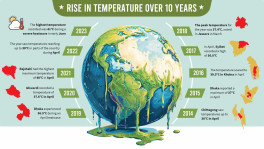Discovering genetic scissors: Taking life sciences into a new epoch
Using CRISPR/Cas9 genetic scissors it is now possible to change the code of life within a few weeks

The Royal Swedish Academy of Sciences awarded this year's Nobel Prize in Chemistry to Emmanuelle Charpentier from Max Planck Unit for the Science of Pathogens, Berlin, Germany and Jennifer A Doudna from the University of California, Berkeley, US, for the development of a method for genome editing.
They discovered one of gene technology's sharpest tools, the CRISPR/Cas9 genetic scissors for rewriting the code of life. Using these, researchers can change the DNA of animals, plants and microorganisms with extremely high precision. This technology has had a revolutionary impact on the life sciences, is contributing to new cancer therapies and may make the dream of curing inherited diseases come true.
Researchers need to modify genes in cells if they are to find out about life's inner workings. This used to be time-consuming, difficult and sometimes impossible work. Using the CRISPR/Cas9 genetic scissors, it is now possible to change the code of life within a few weeks. There is enormous power in this genetic tool, which affects us all. It has not only revolutionised basic science but also resulted in innovative crops and will lead to ground-breaking new medical treatments.

As so often in science, the discovery of these genetic scissors was unexpected. During Emmanuelle Charpentier's studies of Streptococcus pyogenes, one of the bacteria that cause the most harm to humanity, she discovered a previously unknown molecule, tracrRNA.
Her work showed that tracrRNA is part of bacteria's ancient immune system, CRISPR/Cas9, that disarms viruses by cleaving their DNA.
Charpentier published her discovery in 2011. The same year, she initiated a collaboration with Jennifer Doudna, an experienced biochemist with a vast knowledge of RNA. Together, they succeeded in recreating the bacteria's genetic scissors in a test tube and simplifying the scissors' molecular components so they were easier to use.
In an epoch-making experiment, they then reprogrammed the genetic scissors. In their natural form, the scissors recognise DNA from viruses, but Charpentier and Doudna proved that they could be controlled so that they can cut any DNA molecule at a predetermined site. Where the DNA is cut it is then easy to rewrite the code of life.
Since Charpentier and Doudna discovered the CRISPR/Cas9 genetic scissors in 2012 their use has exploded. This tool has contributed to many important discoveries in basic research, and plant researchers have been able to develop crops that withstand mould, pests and drought. In medicine, clinical trials of new cancer therapies are underway, and the dream of being able to cure inherited diseases is about to come true. These genetic scissors have taken the life sciences into a new epoch and, in many ways, are bringing the greatest benefit to humankind.
The gene editor called CRISPR/Cas9 is one such unexpected discovery with breathtaking potential. When Charpentier and Doudna started investigating the immune system of a Streptococcus bacterium, one idea was that they could perhaps develop a new form of antibiotic. Instead, they discovered a molecular tool that can be used to make precise incisions in genetic material, making it possible to easily change the code of life.
Just eight years after their discovery, these genetic scissors have reshaped the life sciences. Biochemists and cell biologists can now easily investigate the functions of different genes and their possible role in the progression of the disease. In-plant breeding, researchers can give plants specific characteristics, such as the ability to withstand drought in a warmer climate. In medicine, this gene editor is contributing to new cancer therapies and the first studies attempting to cure inherited diseases.
When viruses infect a bacterium, they send their harmful DNA into it. If the bacterium survives the infection, in inserts a piece of the virus DNA in its genome, like a memory of the virus. This DNA is then used to protect the bacterium from new infections. The bacterium inserts a piece of the virus DNA in the CRISPR section of the genome. Between each viral DNA is a repeated sequence.
CRISPR DNA is copied to make a long RNA molecule. TracrRNA fits with the repeated section of CRISPR RNA like a piece of a puzzle. When tracrRNA attaches to CRISPR RNA, the scissor protein Cas9 also links to the complex. The long molecule is then cleaved into smaller pieces by a protein called RNase III. The finished genetic scissors contain code from a single virus. If the bacterium is reinfected by the same virus, the genetic scissors will immediately recognise and disarm the virus by cleaving it.
The researchers decided to try to simplify genetic scissors. Using their new knowledge about tracrRNA and CRISPR-RNA, they figured out how to fuse the two into a single molecule, which they named guide RNA. With this simplified variant of the genetic scissors, they then undertake an epoch-making experiment: they investigate whether they can control this genetic tool so that it cuts the DNA at a location decided by the researchers.
When researchers are going to edit a genome using the genetic scissors, they artificially construct a guide RNA, which matches the DNA code where the cut is to be made. The scissor protein, Cas9, forms a complex with the guide RNA, which takes the scissors to the place in the genome where the cut will be made. Researchers can allow the cell itself to repair the cut in the DNA. In most cases, this leads to the gene's function is turned off. If the researchers want to insert, repair or edit a gene, they can specially design a small DNA template for this. The cell will use the template when it repairs the cut in the genome, so the code in the genome is changed.
Genetic scissors have also become a standard tool in plant breeding. When the crops were planted, there was a risk of this antibiotic resistance spreading to the surrounding microorganisms. Now, researchers no longer need to use these older methods as they can now make very precise changes to the genome. Among other things, they have edited the genes that make rice absorb heavy metals from the soil, leading to improved rice varieties with lower levels of cadmium and arsenic.
Researchers have also developed crops that better withstand drought in a warmer climate, and which resist insects and pests that would otherwise have to be dealt with using pesticides. In medicine, the genetic scissors are contributing to new immunotherapies for cancer and trials are underway to make a dream come true – curing inherited diseases. Researchers are already performing clinical trials to investigate whether they can use CRISPR/Cas9 to treat blood diseases such as sickle cell anaemia and beta-thalassemia, as well as inherited eye diseases.
Md Arafat Rahman is an Assistant Officer, Career & Professional Development Services Department, Southeast University


 Keep updated, follow The Business Standard's Google news channel
Keep updated, follow The Business Standard's Google news channel















